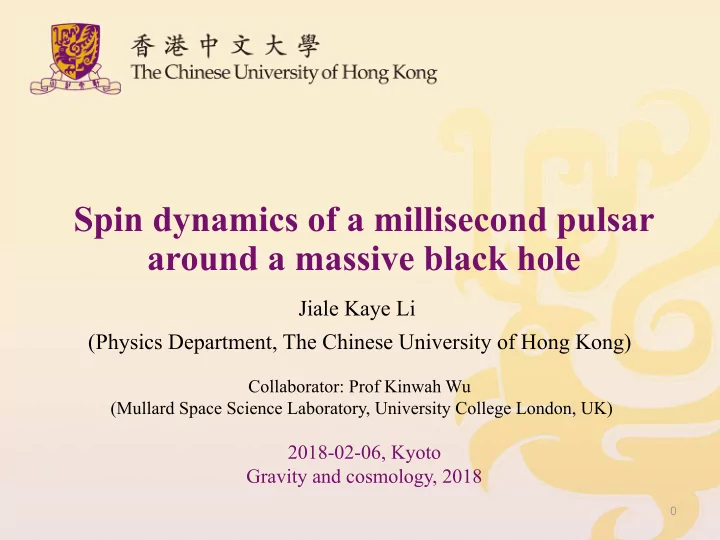

Spin dynamics of a millisecond pulsar around a massive black hole Jiale Kaye Li (Physics Department, The Chinese University of Hong Kong) Collaborator: Prof Kinwah Wu (Mullard Space Science Laboratory, University College London, UK) 2018-02-06, Kyoto Gravity and cosmology, 2018 0
Outline Theory Mathisson–Papapetrou–Dixon (MPD) formulation Simulation and interesting results spin precession orbital precession Pulsar observation Gravitational wave 1
Motion of test particle • Weak Equivalence Principle The world line of a freely falling test body is independent of its composition or structure. • Non-spinning object – geodesic equation 2
Motion of extended body • Spinning object – Mathisson-Papapetrou-Dixon equations Spin-curvature coupling and spin-orbit coupling Precession of spin axis Hidden momentum 3
EMRI binary system 4
Outline Theory Mathisson–Papapetrou–Dixon (MPD) formulation Simulation and interesting results spin precession orbital precession Pulsar observation Gravitational wave 5
Precession of the NS orbit Geodesics precession Corrections due to spin 6
Non-planar orbital motion The precession of the orbital plane 10 8 6 a/M=0.99 ( λ =1) 4 30 2 20 0 10 -2 z [km] 0 -4 -10 -6 -20 -8 -10 -30 0 10 20 30 40 50 60 70 80 90 100 -15 -10 -5 0 5 10 15 t [sec] x [M] a/M=-0.99 ( λ =1) 8 6 4 a/M=-0.99 ( λ =1) 30 2 20 0 10 z [km] -2 0 -4 -10 -6 -20 -30 -8 -20 -15 -10 -5 0 5 10 15 20 0 10 20 30 40 50 60 70 80 90 100 t [sec] x [M] (Singh, Wu, and Sarty, 2014) 7
Deviation from the geodesics 60 50 retrograde 40 low eccentricity r (km) 30 (quasi-circular) 20 prograde 10 0 0 5 10 15 20 t (s) e=0.10 e=0.20 e=0.30 eccentric 8
Precession of spinning-axis Black hole (image credit: H. Sulzer) 9
Precession of spinning-axis Pulses received by distance observer time ü Pulse profile changes or even disappears when the spinning-axis wobbles around ü Assume a conal emission ~10 o , the time shifts by about and . 10
Nutation of spinning-axis (image credit: H. Sulzer) 11
Gravitational lensing effect A small perturbation ~10 $% rad becomes up to ~ 0.1 rad due to lensing • of the black hole Red solid lines: photon paths with different impact parameter Colorful lines: photon paths with perturbed initial velocity 12
Outline Theory Mathisson–Papapetrou–Dixon (MPD) formulation Simulation and interesting results spin precession orbital precession Pulsar observation Gravitational wave 13
Spin-axis wobbling effect ü Pulse time shift: ü Pulse profile shift: spin axis wobbling spin axis magnetic field axis period (Rafikov and Lai 2008) 14
Flat space-time with plasma Temporal dispersion of pulse signals ü Pulse arrival time dispersion in the presence of line-of-sight plasma ü Pulse emission in all frequencies follow the same trajectory but will arrive at different time (Lorimer, D Ross, and M Kramer) 15
Curved space-time with plasma Frequency dependent spatial dispersion of emission non-rotating rotating black hole black hole (Kimpson, Wu and Zane 2018) ü Emission of different frequencies have different paths under the gravity of a rotating black hole 16
Outline Theory Mathisson–Papapetrou–Dixon (MPD) formulation Simulation and interesting results spin precession orbital precession Pulsar observation Gravitational wave 17
LISA band (image credit: Moore, Cole and Berry) 18
LISA band The definition of orbital plane, inclination angle, etc… (Peters, P 1963) 19
Summary 1. Spin-curvature coupling: - Non-geodesic motion - Precession and nutation of pulsar’s spin axis 2. Implication on pulsar observation: - Orbital precession would shift the arrival time of pulses - Spin precession would distort the pulse profile and even lead to the disappearance of pulses - Emission with different frequencies have spatial and temporary dispersion 3. Gravitational wave: - Corrections to phase to gravitational wave and distortion of the waveform 20
Reference ü Singh, Dinesh, Kinwah Wu, and Gordon E. Sarty. "Fast spinning pulsars as probes of massive black holes’ gravity." Monthly Notices of the Royal Astronomical Society 441.1 (2014): 800-808. ü Peters, P. (n.d.). Gravitational Radiation from Point Masses in a Keplerian Orbit. ü Kramer, Michael, et al. "Tests of general relativity from timing the double pulsar." Science 314.5796 (2006): 97-102. ü Lorimer, Duncan R. "Binary and millisecond pulsars." Living reviews in relativity 11.1 (2008): 8. ü Rafikov, Roman R., and Dong Lai. "Effects of Pulsar Rotation on Timing Measurements of the Double Pulsar System J0737–3039." The Astrophysical Journal 641.1 (2006): 438. ü Lorimer, Duncan Ross, and Michael Kramer. Handbook of pulsar astronomy . Vol. 4. Cambridge university press, 2005. 21
Acknowledgement I would like to thank Prof Kinwah Wu and Dr Leung Po Kin for useful discussion and suggestions on the project. I thank Otto, Adrian C, Adrian L for suggestions on the slide and presentation. I thank the Physics department and Tjonnie Li for funding my visit to Kyoto. 22
Recommend
More recommend